Get free scan and check if your device is infected.
Remove it nowTo use full-featured product, you have to purchase a license for Combo Cleaner. Seven days free trial available. Combo Cleaner is owned and operated by RCS LT, the parent company of PCRisk.com.
What kind of malware is GrokPy?
GrokPy is malware that collects system information, escalates privileges, and abuses browser capabilities to carry out its tasks. It also communicates with a command-and-control server throughout the infection process, enabling remote coordination and updates. Notably, the malware integrates CAPTCHA-solving functionality to bypass security checks.

More about GrokPy
Once infiltrated, GrokPy gathers details about the infected device, including screen size, IP address, location, RAM usage, and CPU information. It also attempts to run with administrator rights or sets itself up as a scheduled task. This gives the malware more control and makes it harder to remove.
Furthermore, GrokPy takes advantage of the Chrome Developer Protocol. By abusing this functionality, the malware can remotely interact with the victim's browser (both Chrome and Edge). This enables it to perform actions such as taking screenshots, reading information displayed in the browser, or automating tasks.
Moreover, GrokPy can automatically create new Discord accounts using generated emails and passwords. This feature is also used to get authentication tokens and send them to the attackers. It is essential to note that GrokPy communicates with its command-and-control server regularly to receive instructions and updates.
Additionally, the malware uses optical character recognition (OCR) on screenshots taken through CDP to extract text from CAPTCHA images. This helps automate steps that usually require human input. It sends CAPTCHA data to a model hosted on its command-and-control server. The model solves the CAPTCHA, allowing the malware to bypass security checks.
Overall, GrokPy allows cybercriminals to steal data, access online accounts, or use the device for additional attacks. This may result in identity theft, fraud, monetary loss, or other serious consequences.
| Name | GrokPy stealer |
| Threat Type | Stealer |
| Detection Names | Avast (FileRepMalware [Misc]), Combo Cleaner (Gen:Variant.Tedy.837844), ESET-NOD32 (Python/Agent.BLK Trojan), Kaspersky (Trojan.Win64.Agent.smeylv), Microsoft (Trojan:Win32/Wacatac.B!ml), Full List (VirusTotal) |
| Symptoms | Stealers tend to be designed to stealthily infiltrate the victim's computer and remain silent, and thus no particular symptoms are clearly visible on an infected machine. |
| Possible distribution methods | Infected email attachments, malicious online advertisements, social engineering, software vulnerabilities, software 'cracks'. |
| Damage | Stolen passwords and banking information, identity theft, monetary loss, or other issues. |
| Malware Removal (Windows) |
To eliminate possible malware infections, scan your computer with legitimate antivirus software. Our security researchers recommend using Combo Cleaner. Download Combo CleanerTo use full-featured product, you have to purchase a license for Combo Cleaner. 7 days free trial available. Combo Cleaner is owned and operated by RCS LT, the parent company of PCRisk.com. |
Conclusion
GrokPy's ability to gather system data, interact with browsers, communicate with a command-and-control server, and bypass CAPTCHA protections makes it a dangerous threat. Using these capabilities, the malware can carry out various malicious tasks. If detected on a device, GrokPy should be removed as soon as possible.
How did GrokPy infiltrate my computer?
Malware can be delivered through various channels, including compromised or deceptive websites, misleading advertisements, infected USB drives, peer-to-peer platforms, and notifications from untrustworthy pages. Typically, users infect systems through malicious executable files, Office or PDF documents, scripts, and archives such as ZIP or RAR.
Cybercriminals also exploit vulnerabilities in outdated software, use tech support scams, pirated programs (and cracks or keygens), third-party downloaders, and deceptive emails that contain harmful attachments or links to trick users into downloading and executing malware.
How to avoid installation of malware?
Be careful with unexpected emails or messages, especially if they come from unknown senders, and avoid opening their attachments or any links they include. Keep the device protected by regularly updating your operating system, apps, and security software, and running periodic scans.
Only download programs from legitimate sources, such as official developer websites or well-known app stores. When browsing, steer clear of interacting with ads, pop-ups, or any clickable items on sites that seem untrustworthy, and decline any notification requests from them. If you believe that your computer is already infected, we recommend running a scan with Combo Cleaner Antivirus for Windows to automatically eliminate infiltrated malware.
Instant automatic malware removal:
Manual threat removal might be a lengthy and complicated process that requires advanced IT skills. Combo Cleaner is a professional automatic malware removal tool that is recommended to get rid of malware. Download it by clicking the button below:
DOWNLOAD Combo CleanerBy downloading any software listed on this website you agree to our Privacy Policy and Terms of Use. To use full-featured product, you have to purchase a license for Combo Cleaner. 7 days free trial available. Combo Cleaner is owned and operated by RCS LT, the parent company of PCRisk.com.
Quick menu:
How to remove malware manually?
Manual malware removal is a complicated task - usually it is best to allow antivirus or anti-malware programs to do this automatically. To remove this malware we recommend using Combo Cleaner Antivirus for Windows.
If you wish to remove malware manually, the first step is to identify the name of the malware that you are trying to remove. Here is an example of a suspicious program running on a user's computer:
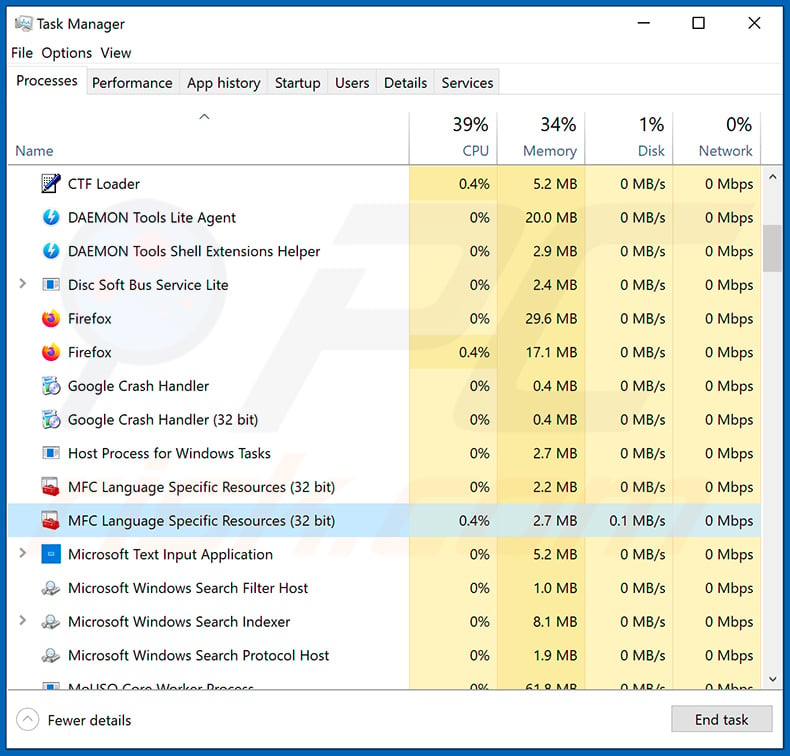
If you checked the list of programs running on your computer, for example, using task manager, and identified a program that looks suspicious, you should continue with these steps:
 Download a program called Autoruns. This program shows auto-start applications, Registry, and file system locations:
Download a program called Autoruns. This program shows auto-start applications, Registry, and file system locations:
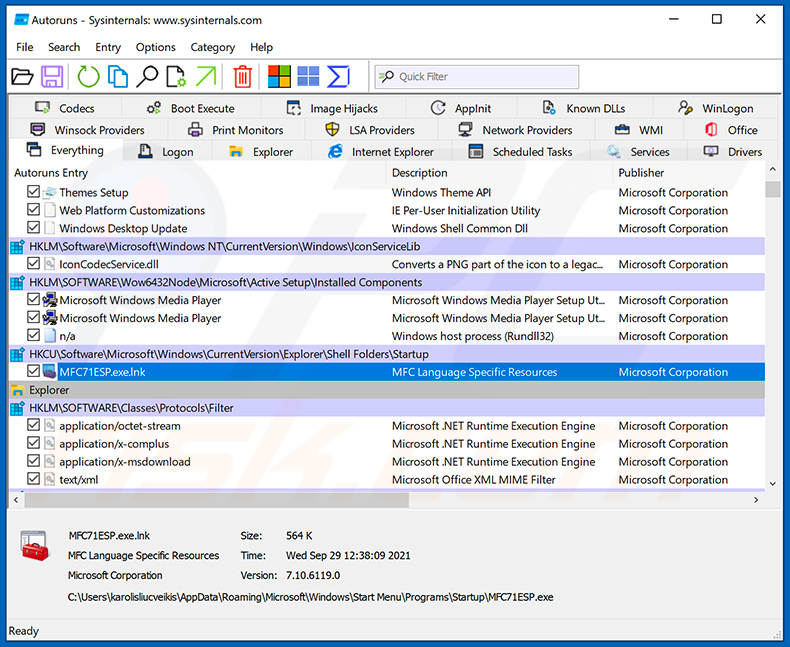
 Restart your computer into Safe Mode:
Restart your computer into Safe Mode:
Windows XP and Windows 7 users: Start your computer in Safe Mode. Click Start, click Shut Down, click Restart, click OK. During your computer start process, press the F8 key on your keyboard multiple times until you see the Windows Advanced Option menu, and then select Safe Mode with Networking from the list.
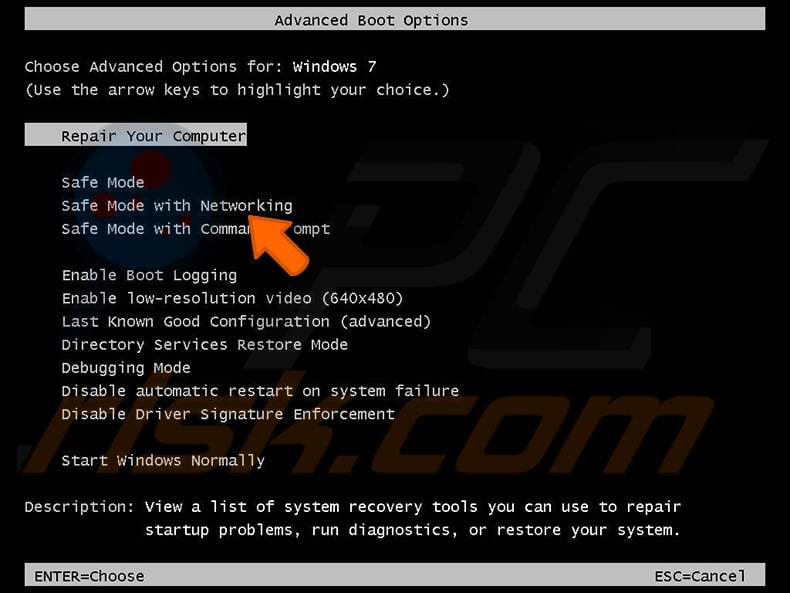
Video showing how to start Windows 7 in "Safe Mode with Networking":
Windows 8 users: Start Windows 8 is Safe Mode with Networking - Go to Windows 8 Start Screen, type Advanced, in the search results select Settings. Click Advanced startup options, in the opened "General PC Settings" window, select Advanced startup.
Click the "Restart now" button. Your computer will now restart into the "Advanced Startup options menu". Click the "Troubleshoot" button, and then click the "Advanced options" button. In the advanced option screen, click "Startup settings".
Click the "Restart" button. Your PC will restart into the Startup Settings screen. Press F5 to boot in Safe Mode with Networking.

Video showing how to start Windows 8 in "Safe Mode with Networking":
Windows 10 users: Click the Windows logo and select the Power icon. In the opened menu click "Restart" while holding "Shift" button on your keyboard. In the "choose an option" window click on the "Troubleshoot", next select "Advanced options".
In the advanced options menu select "Startup Settings" and click on the "Restart" button. In the following window you should click the "F5" button on your keyboard. This will restart your operating system in safe mode with networking.
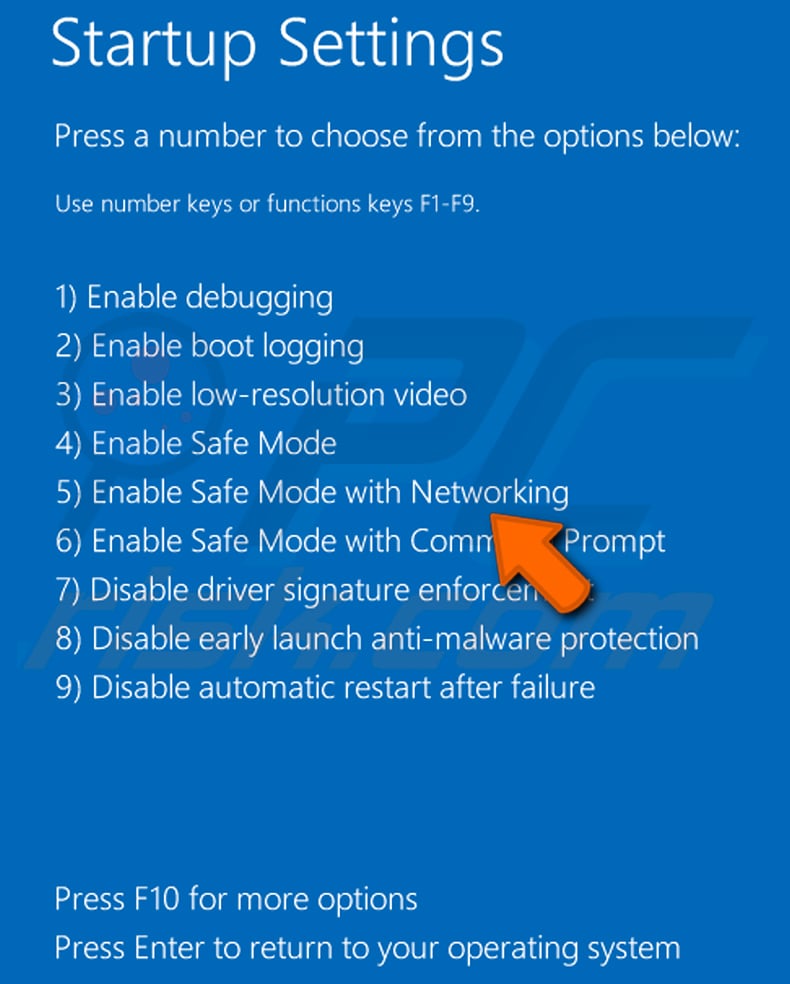
Video showing how to start Windows 10 in "Safe Mode with Networking":
 Extract the downloaded archive and run the Autoruns.exe file.
Extract the downloaded archive and run the Autoruns.exe file.

 In the Autoruns application, click "Options" at the top and uncheck "Hide Empty Locations" and "Hide Windows Entries" options. After this procedure, click the "Refresh" icon.
In the Autoruns application, click "Options" at the top and uncheck "Hide Empty Locations" and "Hide Windows Entries" options. After this procedure, click the "Refresh" icon.

 Check the list provided by the Autoruns application and locate the malware file that you want to eliminate.
Check the list provided by the Autoruns application and locate the malware file that you want to eliminate.
You should write down its full path and name. Note that some malware hides process names under legitimate Windows process names. At this stage, it is very important to avoid removing system files. After you locate the suspicious program you wish to remove, right click your mouse over its name and choose "Delete".

After removing the malware through the Autoruns application (this ensures that the malware will not run automatically on the next system startup), you should search for the malware name on your computer. Be sure to enable hidden files and folders before proceeding. If you find the filename of the malware, be sure to remove it.
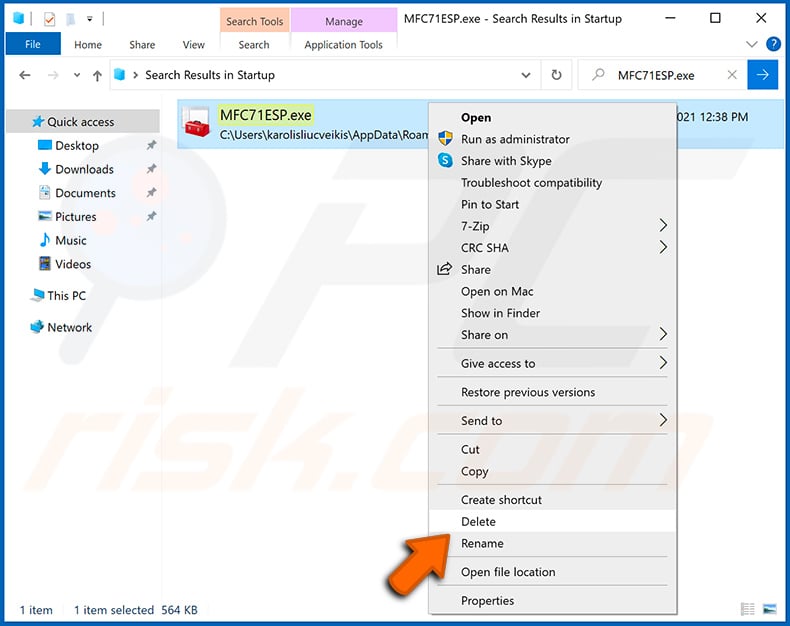
Reboot your computer in normal mode. Following these steps should remove any malware from your computer. Note that manual threat removal requires advanced computer skills. If you do not have these skills, leave malware removal to antivirus and anti-malware programs.
These steps might not work with advanced malware infections. As always it is best to prevent infection than try to remove malware later. To keep your computer safe, install the latest operating system updates and use antivirus software. To be sure your computer is free of malware infections, we recommend scanning it with Combo Cleaner Antivirus for Windows.
Frequently Asked Questions (FAQ)
My computer is infected with GrokPy malware, should I format my storage device to get rid of it?
Formatting the storage device is not always required. We advise users to use a reputable antivirus/anti-malware tool like Combo Cleaner to check for and remove the infection. Many threats can be cleaned without erasing all data.
What are the biggest issues that malware can cause?
Malware can steal personal data, hijack accounts, cause financial loss, damage files or systems, and spread additional threats. It can also lead to identity theft, privacy breaches, and other issues.
What is the purpose of GrokPy?
GrokPy can automate malicious tasks on an infected device, gather system information, steal credentials, and abuses the browser to perform malicious actions. It can also bypass CAPTCHAs.
How did a malware infiltrate my computer?
Malware can infiltrate devices through fake websites, ads, USB drives, peer-to-peer platforms, and untrustworthy notifications. Users often get infected by opening malicious files like executables, documents, scripts, or archives. Cybercriminals also exploit outdated software, scams, pirated programs, third-party downloaders, and deceptive emails to trick users into running malware.
Will Combo Cleaner protect me from malware?
Combo Cleaner can detect and remove nearly all known malware. However, advanced threats often hide deep within the system, so performing a full system scan is essential.
Share:

Tomas Meskauskas
Expert security researcher, professional malware analyst
I am passionate about computer security and technology. I have an experience of over 10 years working in various companies related to computer technical issue solving and Internet security. I have been working as an author and editor for pcrisk.com since 2010. Follow me on Twitter and LinkedIn to stay informed about the latest online security threats.
PCrisk security portal is brought by a company RCS LT.
Joined forces of security researchers help educate computer users about the latest online security threats. More information about the company RCS LT.
Our malware removal guides are free. However, if you want to support us you can send us a donation.
DonatePCrisk security portal is brought by a company RCS LT.
Joined forces of security researchers help educate computer users about the latest online security threats. More information about the company RCS LT.
Our malware removal guides are free. However, if you want to support us you can send us a donation.
Donate
▼ Show Discussion